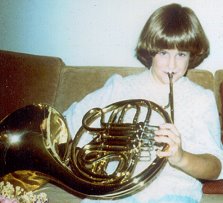So to celebrate, today I am going to break my yoga fast and try to do some gentle poses - YAY! I have so missed my yoga routine both physically and especially mentally. As far as activity, I am now going to try to intentionally incorporate more walking into my daily routine.
Thanks so much to all of you who wrote comments, sent emails, and called...you're wonderful, and I love you for it.
Warning: Remainder of this post is nothing but impossibly nerdy horn geek writing, and is not recommended for the well-adjusted, emotionally mature, or mentally sane.
This week we're doing Donizetti's "Daughter of the Regiment". It's refreshingly fluffy and light after that gluttonous Tchaikovsky smorgasborg, and I am just loving it. The weird thing about a lot of opera horn parts is the transposition. See, when most operas were written, horns didn't have valves. You had to switch different lengthed slides, known as "crooks", that pitched the horn's overtones into a certain key so you could play in different keys. So, if you, the jolly horn player, saw in your part that the upcoming tenor aria was in the key of A Basso, you'd get your A Basso crook out of your crook bag and stick it on your valveless horn and bingo, your horn would be pitched in A Basso.
Here's what a Natural Horn looks like with crooks; these crooks attach to the top of the horn and each have their own "lead pipe" (the end the mouthpiece goes in, the end you blow into):
Well now, of course, all of this crooked silliness (groan) is unnecessary, since modern horns have valves and can switch between crooks just by pressing a lever (instead of having to disembowel the thing to slap on another crook). Here's what my fancy ultra-valved triple horn looks like again:
The problem is, the opera parts haven't changed to reflect this. So we have to transpose.
Here's how it works. The modern horn of today lives in Hornland, otherwise known as the Republic of the Key of F. So the Key of F is our home base; we always travel from this key to get to the other keys requested of us. When an aria is in a key other than F, the poor horn player has to travel from F up or down to get to the key requested.
For instance, if the key is G, then the horn player only has to travel up one step to be in the key necessary. So if the piece is in G, s/he will have to play every single printed pitch up one full step in order to be in the foreign key. Does this make sense? If the piece is in Eb, everything will be down one full step since traveling from Hornland (the key of F) to Eb is one full step.
What gets hairy is when the distance between Hornland and the requested key is very large and not a "perfect" interval like a 4th or 5th. A Basso is a pain in the ass because you have to play every damn note down a minor 6th. That's a brain scrambler.
Thankfully some blessed soul wrote in a lot of my A Basso transpositions! Dude/tte, whoever you are, thanks a mil! Seriously! Fortunately this is not at all distracting since the original note is so far above the note you'll actually be playing that there's plenty of staff room below to write things in.
Anyway, so there's much more I'm sure than you ever wanted to know about horn playing, transposing, and other totally horn-geek related issues.
XO Darcy the Horn Nerd







No comments:
Post a Comment